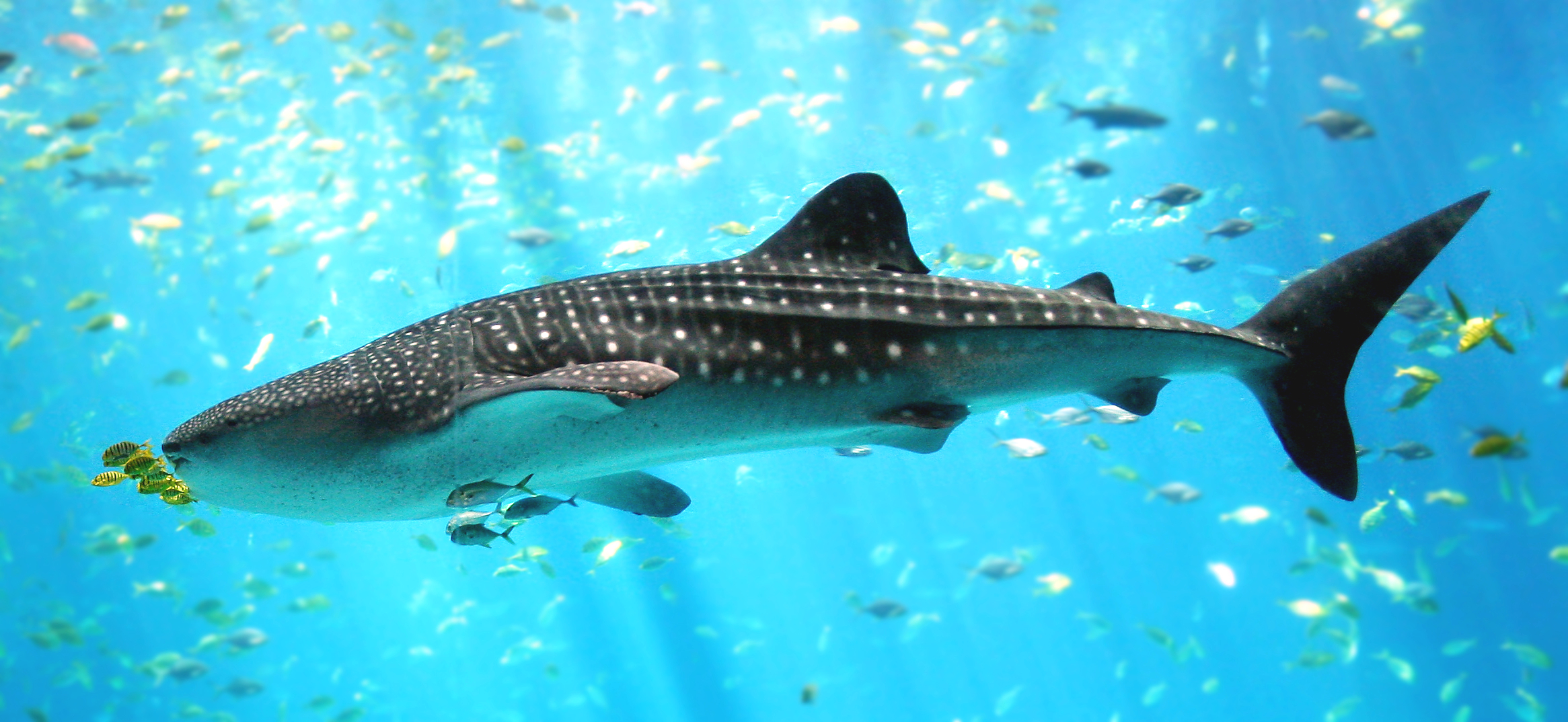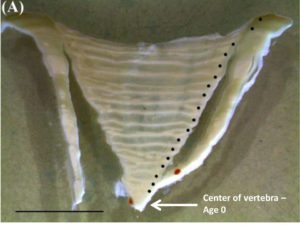Ong, J. J. L., Meekan, M. G., Hsu, H. H., Fanning, L. P., & Campana, S. E. (2020). Annual bands in vertebrae validated by bomb radiocarbon assays provide estimates of age and growth of whale sharks. Frontiers in Marine Science, 7(188), 1–7. doi: 10.3389/fmars.2020.00188
How is the largest fish in our ocean so elusive? Whale sharks can grow to over 40 feet long (about the size of a standard school bus) and feed almost entirely on small organisms floating in the water. Whale sharks fascinate not only scientists, but tourists as well, spurring a growing, multi-million dollar tourism industry. And yet, we know surprisingly little about where these gentle giants travel, how they grow, reproduce, or even how long they live.
To properly manage and conserve the declining populations of whale sharks, scientists must first understand more about their biology and how they live. It is easier to learn about life history traits in some species, like those that can easily be kept in aquariums or observed routinely in the wild, than it is for more elusive species. Scientists have developed a range of tools to help them learn more about the life history of fishes and how they age.

How can you tell how old a fish is?
Scientists estimate how old an individual is by looking at different body tissues that continually grow throughout an animal’s life. For example, in fish, scientists have used fin rays, scales, eye tissue, and most commonly, inner ear bones, called otoliths. Since these structures continually grow throughout a fish’s life, they continually accumulate more tissue, forming bands on the bone. Much like aging a tree, scientists estimate the age of fish by counting the bands deposited in these bones.
But sharks are cartilaginous, so they do not have bony spines or otoliths for scientists to use for age estimates. Instead, scientists investigating shark age must look at the vertebrae. Even though these are like the true bony structures in other fish, the vertebrae do grow as a shark ages, and similar to otoliths, they develop bands that scientists examine to estimate an individual’s age. These bands, called annuli, are typically assumed to represent a single year of growth –so a shark that has 3 annuli in a vertebra is assumed to be 3 years old.
How many annuli are in a whale shark vertebra?

To figure out how old whale sharks can be, a team of scientists led by Dr. Joyce J.L. Ong counted the number of annuli in 20 different whale sharks. All of these sharks had been either previously caught by fisheries in 2005 (prior to the closure of the Taiwanese fishery) or had been found dead on beaches. Based only on the number of annuli, all of the whale sharks had been at least 15 years old when they were caught by fishermen and one shark was 50 years old when it was stranded on a beach!
But, the scientists couldn’t stop there because not all species lay down a single band every year. In some species, there may be fewer or greater numbers of bands corresponding to a single year of growth. Even though 15 – 50 annuli had been counted, those numbers were meaningless without understanding how quickly a whale shark grows and forms an annulus on a vertebra. The scientists needed ground truth their measurements with a calibration.
Calibrating age estimates using chemical markers
A common method for calibrating age estimates is to expose a shark to a chemical. When the chemical is absorbed by the shark and incorporated into the vertebrae, it acts like a marker – a known time point on the shark’s vertebral life map. Scientists can then collect the shark at a later date and see how many annuli have been laid down since the exposure to the chemical tag. If a scientist were to look at a vertebra of a shark 3 years after it was exposed to a tag and find that 6 annuli have been laid down after the tag, for instance, they could determine that the species forms annuli twice a year, not just once.
While these chemical tags can be very useful for smaller, shorter lived individuals that are easily caught and recaptured or kept in aquariums, they are nearly impossible to use on large, elusive species like whale sharks. Scientists can, however, make use of chemicals that persist in the environment to help pin down an animal’s age, particularly if that individual was alive during the Cold War.
The nuclear arms race left a lasting mark on the planet and its inhabitants.

In the 1950’s and 60’s, nations around the globe locked in a nuclear arms race. Bomb tests surged. One of the bi-products of the nuclear explosions was a rare form of carbon, called Carbon 14. Typically, Carbon 14 exists in very low levels in our environment, but as nuclear bomb trials took effect, the Carbon 14 in our atmosphere spiked. Eventually, the Carbon 14 fallout from the bombs made its way down to land and into the ocean waters. As plants and animals grew, they assimilated this rare form of carbon into their body tissues. Worry over the increasing levels of nuclear fallout materials in the atmosphere and environment helped to spurn the signing of a Limited Test Ban Treaty by the US and USSR in 1963, effectively stopping above ground nuclear bomb trials.
Even though above ground bomb trials had ceased, plants and animals had already accumulated Carbon 14 in their bodies. While it was not necessarily detrimental to their health, the Carbon 14 left a lasting mark – one that can still be seen by scientists today. Sharks alive during bomb trials incorporated Carbon 14 into their tissues, including their vertebrae. Scientists can use this elevated amount of Carbon 14 laid down in vertebrae as a chemical marker, allowing them to estimate the ages of older sharks.
Using nuclear bomb artifacts to calibrate whale shark age
Based on the vertebral annuli counts, one of the vertebra examined by Dr. Ong’s team belonged to a shark that was 50 years old when it had been found dead on a beach in 2012. If that estimate was correct, it meant the shark had been born in 1962 -one year before the Limited Test Ban Treaty was signed. This gave the scientists a way to test their age estimates by using radiocarbon dating to see if the vertebrae had accumulated cold war-era Carbon 14. By testing the amount of Carbon 14 present in individual annuli of the whale shark vertebra, scientists confirmed that the levels were consistent with oceanic Carbon 14 levels of the post-bomb era. The age estimates obtained from the vertebrae were correct.
Knowing how long whale sharks live can help us protect their populations
With their vertebral age estimates validated, scientists proved that whale sharks can live for at least 50 years. Now scientists can look at more specimens to get an even better idea of how whale sharks grow and age. Similar methods have proved how long other shark species are able to live as well (like the incredibly long-lived Greenland Shark that can live over 300 years!) and vastly improves our understanding of shark life history.
Whale sharks are listed as an endangered species by the International Union for the Conservation of Nature (IUCN). Even though many whale shark fisheries have been banned, whale shark populations continue to decline worldwide. Because whale sharks grow slowly and live a long time their populations are more susceptible to past overfishing events. Today, they still face a host of threats, like boat traffic, oil and gas exploration, illegal fishing, and entanglement in fishing gear. As scientists learn more about whale shark populations, growth, age, and reproduction rates, they can make better decisions on how to properly manage and protect these beautiful giants.
I received my Master’s degree from the University of Rhode Island where I studied the sensory biology of deep-sea fishes. I am fascinated by the amazing animals living in our oceans and love exploring their habitats in any way I can, whether it is by SCUBA diving in coral reefs or using a Remotely Operated Vehicle to see the deepest parts of our oceans.

